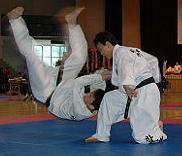|
Hankido is a relatively new hapkido style,
developed by the late Myung Jae Nam. Myung Jae Nam studied traditional
hapkido which formed the basis of this new art. Myung Jae Nam started the
development of what we now know as hankido in the 1980s. This new hapkido
style can be recognized by its elegant, circular movements which the hankido
practitioner uses to get in control of his or her opponent. Of course this
is partly because hankido has its roots partly in hapkido, but also because
Myung Jae Nam, who was a talented dancer, mixed the techniques with
traditional Korean dance. |
 |
|
Hankido is a relatively new
hapkido style, developed by the late Myung Jae Nam. Myung Jae Nam studied
traditional hapkido which formed the basis of this new art. Myung Jae Nam
started the development of what we now know as hankido in the 1980s. This
new hapkido style can be recognized by its elegant, circular movements which
the hankido practitioner uses to get in control of his or her opponent. Of
course this is partly because hankido has its roots partly in hapkido, but
also because Myung Jae Nam, who was a talented dancer, mixed the techniques
with traditional Korean dance. This part of hankido is called: Moo Yae Do
Bub (무예도법).
Hankido was first officially introduced during the 1st International H.K.D
Games in Seoul, South-Korea. The development of hankido did not stop there,
and in the years after its introduction hankido lost some of its rough
edges.
Hankido is a relatively new hapkido style, developed by the late Myung Jae
Nam. Myung Jae Nam studied traditional hapkido which formed the basis of
this new art. Myung Jae Nam started the development of what we now know as
hankido in the 1980s. This new hapkido style can be recognized by its
elegant, circular movements which the hankido practitioner uses to get in
control of his or her opponent. Of course this is partly because hankido has
its roots partly in hapkido, but also because Myung Jae Nam, who was a
talented dancer, mixed the techniques with traditional Korean dance. This
part of hankido is called: Moo Yae Do Bub (무예도법).
Hankido was first officially introduced during the 1st International H.K.D
Games in Seoul, South-Korea. The development of hankido did not stop there,
and in the years after its introduction hankido lost some of its rough
edges.
Hankido consists of twelve basic self-defense techniques (ho shin ki, 호신기)
which are connected to 24 breathing techniques: twelve for the defender
called 'Techniques of the Sky' (Chun Ki Bub, 천기법, 天氣法) and twelve techniques
for the attacker called 'Techniques of the Earth' (Ji Ki Bub, 지기법, 地氣法).
Heaven and Earth are each others opposites and thus resemble the Chinese Um
(Yin) and Yang.
8 Disciplines of Hankido
1. Ho Shin Do Bup (Self defense)
2. Moo Ye Do Bup (Spinning/dancing techniques)
3. Su Jok Do Bup (Striking techniques)
4. Kyuk Ki Do Bup (Sparring techniques)
5. Ki Hap Do Bup (Ki-development techniques)
6. Byung Sool Do Bup (Weaponry)
7. Su Chim Do Bup (Use of pressure points)
8. Hwan Sang Do Bup (Visualisation and breathing exercises) |













